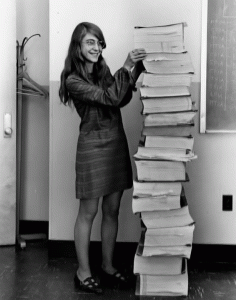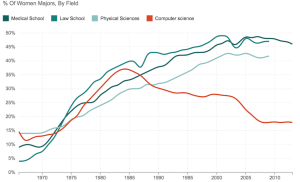By Reagan McCreary

A flaw in the Apollo 11 Lunar lander’s radar system began sending loads of false data to its onboard computer three minutes before the lander reached the moon’s surface. Fortunately, NASA programmer Margaret Hamilton designed a system “smart enough to recognize that it was being asked to perform more tasks than it should be performing.” Without her work, we would not remember the Apollo 11 mission as the first to place human beings on the moon (alive).
Katherine Johnson calculated the flight trajectories for the Apollo 11 mission. Ada Lovelace wrote what we now recognize as the very first computer program. Grace Hopper wrote the first compiler, which is the software that turns raw code into a set of instructions understandable by a computer. Barbara H. Liskov’s research enabled the design and implementation of object-oriented programming languages, which are the most widely used languages today. While recuperating from childbirth, Erna Schneider Hoover came up with a computerized telephone system which revolutionized telecommunication in the 1950’s.
These are a small number of the many women whose work in the early days of computing showed that the Y-chromosome has nothing to do with the potential to succeed in the field. From the advent of the modern computer until around 1984, the ratio of female to male computer scientists increased steadily:

But what happened in 1984?
A bunch of white dudes happened.
Early personal computers required much more hands-on coding than today’s, and they were primarily marketed toward men as a tool and toward boys as a toy. As sad and hilarious as this advertisement appears to us now, the culture of the 1980’s was effective in encouraging boys lucky enough to have access to a Commodore 64 to play games and learn how to code. The same culture taught girls to attract men and become homemakers with their Tinkerbell Makeup and Barbie Dreamhouses.
Because the first commercial computers required complex knowledge for effective use, the first few who truly understood them typically preferred time spent learning alone above interpersonal interaction. Gradually, the stereotype of the socially awkward programmer geek took flight, pushing more women away from the field. Not only is programming for boys; it’s for “weird,” arrogant boys with bad hygiene and no fashion sense who love to creep people out.
This is especially problematic now that computer science is so vital in our society. The ever-increasing human dependency on thinking machines places certain people in an elite class of knowledge. Our economy values technical skill and rewards it with higher pay. Discouraging women from entering highly technical and challenging fields can only serve to widen the existing gender gap.
The idea that select people can enter these fields belies the nature of computer programming. Too many people fail to meet the challenge of learning math or programming because they’re “not good at it” or it’s “not intuitive” to them. I take every opportunity to correct people who say things like this. In reality, if you can understand this sentence, then you can understand the pure logic of programming. It’s just too easy to give up early when you believe, consciously or not, that you inherently lack the ability to do something. Our culture produces an environment which allows budding female professionals to believe that their efforts toward learning math and science will ultimately fall short to those of males, that somehow their gender dictates a limit on their ability. Beyond that, women who manage to overcome the barriers preventing them from learning the necessary skills face even greater barriers once employed. Feelings of isolation in a sea of men, constant (often unintentional) acts of microaggression, and environments which treat women as foreign objects can turn even the most capable female programmer away from doing what she loves.
“You can do anything you put your mind to.” I remember hearing phrases like this from the moment I could understand them. Now that I’m older it rings true, at least in my case. I question its validity in general. I decided to study computers in college, and now I can make software. My status as a white, suburban male opened all of the avenues for me, and I felt no pressure to stifle my love for math or science because it would be unbecoming of someone of my gender, race, or socioeconomic class. I cannot say with certainty that I would have made the same decision had I been born anything other than a white male. I definitely would not have made the decision had it been unavailable to me, as it is to many.
